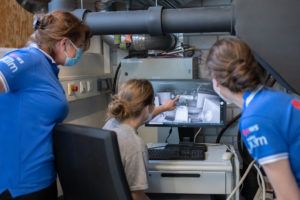Making hybrid-electric flying more efficient, safer and thus commercially viable: This is the goal of the EnaBle research network, which is being funded by the German Federal Ministry for Economic Affairs and Energy with a total of 8 million euros. The aim is to further develop and optimize a highly innovative hybrid propulsion system for air traffic that combines fuel cells and battery systems. At its heart is a 250 kW electric powertrain module using compressed air-fed fuel cells. The University of Ulm is also involved in the project, which is being led by Diehl Aerospace.
Air traffic must become cleaner and quieter in the future. To achieve this, highly innovative solutions for environmentally friendly aircraft engines are needed. Hybrid systems that combine fuel cells and batteries are particularly promising here. Not only do they achieve significantly higher ranges than pure electric aircraft, they also offer the technological potential for upscaling to larger power classes. To accelerate the path to industrial production and commercial exploitation of this sophisticated technology, the German Federal Ministry for Economic Affairs and Energy (BMWi) is funding the EnaBle research consortium with 8 million euros. The consortium includes Diehl Aerospace and MTU Aero Engines, two leading industrial companies from the aerospace sector, as well as the German Aerospace Center (DLR), the DLR spin-off H2Fly and the University of Ulm.
“We are working together to develop a hybrid electric propulsion system consisting of a fuel cell, battery, power electronics and power management system. The specific goal we want to achieve in the process is prompt industrial implementation for light motorized aircraft with up to 19 seats,” explains Ronny A. Knepple. The engineer is responsible for the energy systems division at Diehl Aerospace. The company, which is coordinating the EnaBle research alliance, is a technology leader for avionics systems and a specialist for cockpit equipment.
How do such hybrid systems actually work? “The fuel cell produces electricity from hydrogen and thus provides the energy basis for the propeller drive. Lithium-ion batteries provide additional power needed to reach cruising altitude during takeoff or climb,” says Dr. Caroline Willich, a scientist at the Institute for Energy Conversion and Storage at Ulm University. The engineer is leading the Ulm subprojects together with her institute colleague Dr. Christiane Bauer. Among other things, the air supply module for the fuel cells will be developed at Ulm University. “The fuel cells that are used here are operated with compressed air. Pressurized charging makes the fuel cells more efficient and enables higher performance. This is of particular interest in aircraft, because they move at high altitudes and thus in the negative pressure range,” Willich explains.
The Ulm-based company is also responsible for developing and optimizing the power management system. This must ensure precisely, quickly and fail-safely that the battery provides additional energy for the propulsion system when power requirements are high and can be recharged during the flight. The power management system should be able to respond precisely and application-oriented to the requirements of different flight profiles. A very special unique selling point at the fuel cell research site in Ulm is a test stand that is integrated into a climate-controlled negative pressure chamber. This allows entire powertrain systems to be characterized and tested under realistic, flight-relevant conditions.
Modularization increases scalability and facilitates maintenance and repair
A very central aspect of powertrain development is modularization. On the one hand, the collaborative partners want to use it to increase the scalability of the system, which is ultimately crucial for a prototype to be able to go into series production on an industrial scale. On the other hand, a modular development concept also favors fault detection and rectification, thus making maintenance and repair easier, which in turn leads to greater safety. Hardware and software must be optimally coordinated for this.
A decisive factor for the success of the project is not least the generic computer platform to be developed and deployed within the scope of EnaBle, including comprehensive control and regulation algorithms that are to ensure efficient and smooth operation of the powertrain. For this purpose, Diehl Aerospace provides a so-called Integrated Modular Avionics (IMA). The abbreviation refers to a modular computer-based electronic unit consisting of standardized components and interfaces, which ensures that the various systems in the aircraft can communicate with each other.
The Institute of Technical Thermodynamics at DLR is specifically responsible for developing the fuel cell and battery system. At the University of Ulm – as already described – the focus is on the air supply module for the compressed-air fuel cell, fail-safe power management and testing of the new hybrid powertrain in the university’s own test facility with a climate-controlled vacuum chamber. MTU Aero Engines, Germany’s leading engine manufacturer, is working on the overall integration of the development concept for aircraft in the 19- to 80-seater class. As part of EnaBle, DLR spin-off H2Fly is focusing on clarifying safety requirements and certification issues.
“Industrial companies, research institutions and spin-offs are working hand in hand in EnaBle. Ultimately, the aim is to build up overall system expertise for fuel cell-battery hybrids, which will help strengthen Germany as a technology location and create new jobs,” the project partners are convinced. But the University of Ulm and its students also benefit from this industry-oriented joint project: “EnaBle gives our young scientists the opportunity to conduct application-oriented research in a highly innovative environment. Our engineers learn to work according to standards and quality guidelines, to prepare for the industrialization of products and, at the same time, to drive forward future technologies,” emphasizes Dr. Christiane Bauer.
Further information:
Institute for Energy Conversion and Storage (EWS).
Dr. Christiane Bauer, e-mail: christiane.bauer@uni-ulm.de
Dr. Caroline Willich, e-mail: caroline.willich@uni-ulm.de

